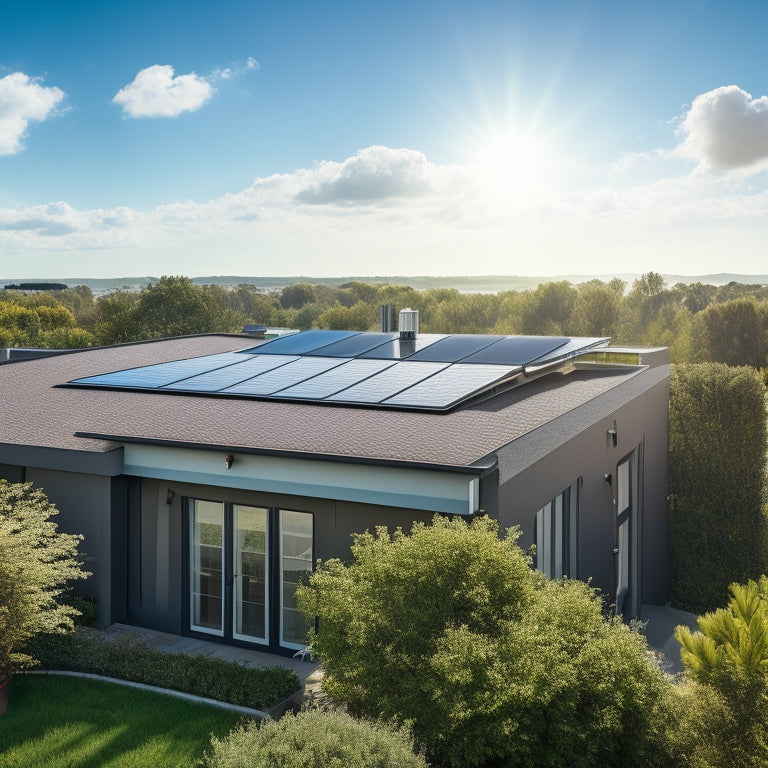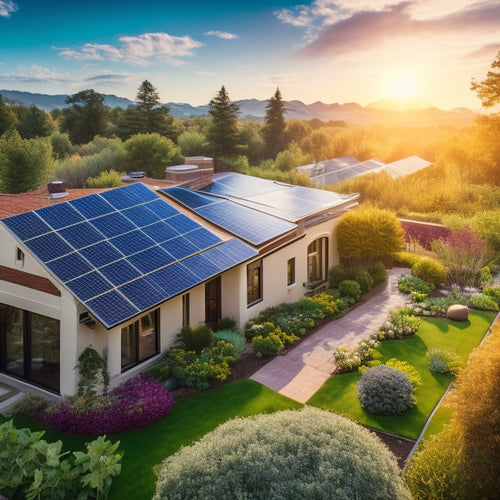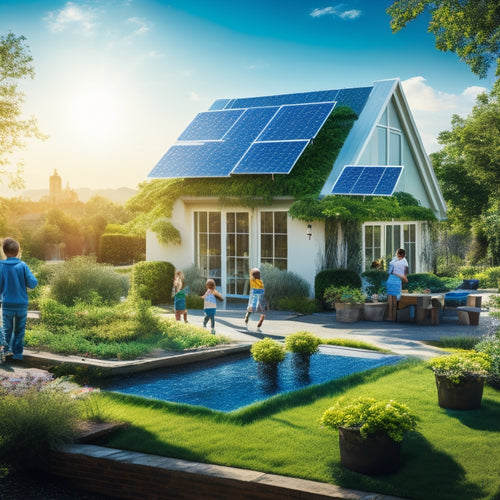
Selecting and Installing Solar Panels for Maximum Residential Energy Efficiency
Share
As you consider selecting and installing solar panels for maximum residential energy efficiency, you'll need to assess your energy needs, choosing the right panel type that suits your budget and preferences. Evaluate panel efficiency ratings, considering power conversion efficiency, temperature coefficient, and durability. Calculate your roof's potential, analyzing roof size, orientation, and shading. Research reputable installers, assessing installation costs, financing options, and government incentives. Additionally, investigate mounting and tracking options, inverter selection, and battery backup and storage. By understanding these essential factors, you'll be well on your way to optimizing your solar energy system - and there's more to uncover.
Key Takeaways
- Assess energy consumption habits and conduct an energy audit to determine the required system size and configuration for maximum efficiency.
- Choose the right panel type based on energy needs, budget, and preferences, considering factors like material, warranty, and efficiency ratings.
- Ensure optimal panel installation by analyzing roof size, orientation, and shading, and calculating available space for maximum energy production.
- Select a reputable installer with certification, experience, and good customer reviews, and ensure compliance with local regulations and building codes.
- Monitor system performance in real-time to maximize energy output, using features like remote access, data analytics, and alert notifications.
Assessing Your Energy Needs
Before investing in solar panels, it's essential to evaluate your energy needs to determine the required system size and configuration.
You'll need to analyze your energy consumption habits, considering factors like the number of occupants, energy-intensive appliances, and lighting usage. Take note of the efficiency of your household appliances, as this will impact your overall energy requirements.
Conduct an energy audit to identify areas of inefficiency and opportunities for improvement.
Review your past utility bills to understand your energy usage patterns and identify peak consumption periods. This will help you determine the ideal system size and configuration for your solar panel installation.
Additionally, consider the orientation and shading of your roof, as well as any local building codes or regulations that may impact your installation.
Choosing the Right Panel Type
With your energy needs assessed, you're now ready to select the right solar panel type for your system. This decision is vital as it affects the system's overall performance, durability, and cost.
You'll encounter various panel materials, each with its strengths and weaknesses. Monocrystalline silicon panels offer high efficiency but are pricier, while polycrystalline silicon panels provide a balance between efficiency and cost. Thin-film panels, on the other hand, are more budget-friendly but less efficient.
When choosing a panel type, consider the warranty offered by the manufacturer. An extensive warranty should cover the panel's performance, materials, and workmanship for at least 25 years. Some manufacturers offer extended warranties or premium warranties that provide additional protection.
Be sure to review the warranty terms and conditions to guarantee you're getting the best coverage for your investment.
Ultimately, the right panel type for you'll depend on your specific needs, budget, and preferences. By understanding the pros and cons of each material and evaluating panel warranties, you'll be able to make an informed decision that optimizes your solar panel system's performance and ROI.
Understanding Panel Efficiency Ratings
Plunge into the world of panel efficiency ratings, where every percentage point counts. When selecting solar panels, you'll encounter various efficiency ratings, which can be overwhelming. But understanding these ratings is vital to maximize your residential energy efficiency.
Efficiency ratings measure a panel's ability to convert sunlight into electricity. The most common rating is the power conversion efficiency (PCE), which is calculated by dividing the maximum power output by the total irradiance incident on the panel.
Look for panels with higher PCE ratings, as they can generate more power per unit area.
Recent panel technology advancements have led to significant improvements in efficiency. For instance, monocrystalline silicon panels boast higher efficiencies than polycrystalline silicon panels.
Efficiency measurement standards, such as those set by the International Electrotechnical Commission (IEC), guarantee that manufacturers provide accurate and comparable ratings.
When evaluating panels, consider the efficiency rating, as well as other factors like temperature coefficient and durability, to confirm you're getting the best value for your investment.
Calculating Your Roof's Potential
You'll need to evaluate your roof's size and shape to determine how many panels can fit and where they'll be most effective.
Additionally, you'll want to analyze the sunlight exposure patterns on your roof, including any obstructions or shading that might impact energy production.
Roof Size and Shape
Calculating your roof's potential for solar panels begins with evaluating its size and shape, two critical factors that greatly impact the amount of energy you can employ.
To determine your roof's suitability, consider the following key aspects:
-
Roof orientation: A south-facing roof receives the most sunlight, making it ideal for solar panels. East- and west-facing roofs can also work well, but north-facing roofs are less suitable.
-
Shading analysis: Identify any obstacles that may cast shade on your roof, such as trees, chimneys, or neighboring buildings. Shading can considerably reduce energy production.
-
Available roof space: Calculate the total area of your roof that's free from obstructions and can accommodate solar panels. This will help you determine the maximum number of panels you can install.
Sunlight Exposure Patterns
Your roof's sunlight exposure pattern plays a vital role in determining its potential for solar panels. To calculate your roof's potential, you need to assess its sunlight exposure, taking into account geographic influences, seasonal variations, and orientation optimization.
A shading analysis will help identify areas with reduced sunlight due to obstacles like trees, buildings, or chimneys. You'll also need to evaluate weather considerations, such as cloud cover, and the sun's path throughout the day.
The number of daylight hours your roof receives is significant, as it directly affects energy production. You can use software or consult with a professional to assess your roof's solar access and identify the best orientation for your solar panels.
Selecting a Reputable Installer
As you prepare to harness the power of solar energy, finding a reliable installer becomes a critical step in the process. You want to confirm that your solar panel system is installed correctly and efficiently to maximize your energy savings.
When researching potential installers, consider the following key factors:
-
Installer Credentials: Verify if the installer is certified by a reputable organization, such as the North American Board of Certified Energy Practitioners (NABCEP).
-
Customer Reviews: Check online reviews from multiple sources, such as Yelp, Google, and the Better Business Bureau, to get a sense of the installer's reputation and customer satisfaction.
-
Installation Warranty: Look for an installer that offers an extensive warranty that covers the system's performance, parts, and labor for a significant period.
Additionally, be sure to ask about the installer's experience, service agreements, financing options, and referral programs.
It's also vital to confirm the installer is familiar with local regulations and can guide you through the permitting process.
Evaluating System Size and Cost
When evaluating a solar panel system, you'll need to take into account system size options that align with your energy needs.
To determine the right size, you'll need to assess your energy usage patterns and identify areas of inefficiency.
System Size Options
Determining the ideal system size for your solar panel installation is essential to achieving energy efficiency and maximizing cost savings.
You want to verify that your system can meet your power demand without over- or under-producing energy.
When evaluating system size options, consider the following key factors:
-
System capacity: The total amount of electricity your solar panel system can produce, typically measured in watts (W).
-
Roof space and layout: The available area on your roof and its orientation will impact the number of panels you can install and their overall efficiency.
-
Local building codes and regulations: Confirm that your system complies with local regulations and building codes to avoid any potential issues or fines.
Determining Energy Needs
One crucial step in evaluating system size and cost is to calculate your energy needs, which involves evaluating your current energy usage patterns.
You'll need to review your past utility bills to determine your average daily energy consumption. This will give you a baseline to work from when selecting a solar panel system. Be certain to take into account factors like seasonal variations, as your energy needs may change throughout the year.
Next, think about your future projections. Are you planning to add more appliances or lighting to your home? Do you anticipate an increase in energy consumption?
Take these factors into account when determining your energy needs. You'll want to guarantee your solar panel system can meet your future energy demands. By accurately calculating your energy needs, you can choose a system that's the right size for your home, providing you with maximum energy efficiency and savings.
Cost-Benefit Analysis
Three key factors - system size, cost, and energy efficiency - must be carefully weighed in a cost-benefit analysis to guarantee you're getting the most out of your solar panel investment.
This evaluation will help you determine whether the benefits of going solar outweigh the costs.
To conduct a thorough cost-benefit analysis, consider the following:
-
Financial benefits: Calculate the total installation costs, financing options, tax incentives, and government rebates. Weigh these against the long-term savings on your utility bills and potential increases in your property value.
-
Environmental benefits: Assess the environmental impact of switching to solar energy, including the reduction in greenhouse gas emissions and your carbon footprint.
-
Energy independence: Consider the value of energy independence, including protection from utility rate changes and reliance on a clean, renewable energy source.
Additionally, factor in ongoing maintenance expenses and the system warranties offered by manufacturers.
Mounting and Tracking Options
Your solar panel system's performance relies on its mounting and tracking setup, which can considerably impact energy output and overall efficiency.
You'll need to decide between fixed mounts and solar trackers, each with its advantages. Fixed mounts are cost-effective and suitable for roofs with consistent angles, while solar trackers optimize energy production by adjusting to the sun's movement.
When it comes to installation, you'll choose between ground mounts and roof mounts. Ground mounts provide flexibility regarding tilt angles and seasonal adjustments, whereas roof mounts are more aesthetically pleasing and often require less installation materials.
Dual axis tracking systems offer maximum energy output but are generally more expensive.
Aesthetic considerations and local regulations will also influence your decision. Verify that your chosen mounting and tracking setup complies with local regulations and suits your property's design.
Inverter Selection and Function
You're now tasked with selecting an inverter that guarantees your solar panel system operates at peak performance.
You'll need to compare inverter types, such as string, micro, and power optimizers, to determine which one maximizes your energy output.
Inverter Type Comparison
Most solar panel systems rely on inverters to convert DC power into AC power, making them an essential component in utilizing renewable energy. When selecting an inverter, you'll encounter three main types: string inverters, microinverters, and hybrid inverters. Each has its benefits and advantages.
Here are the key differences:
-
String Inverters: Offer high efficiency and low cost, but can be affected by shading or panel mismatch. Their benefits include easy installation and monitoring.
-
Microinverters: Provide maximum power harvesting and flexibility, but are more expensive. Their advantages include individual panel monitoring and optimization.
-
Hybrid Inverters: Combine the benefits of string and microinverters, offering high efficiency and flexibility. Their features include built-in grid tie functionality and power optimization.
When comparing inverters, consider factors like efficiency, lifespan, and installation tips. Look for smart inverter technology that integrates with your system and provides real-time monitoring.
Additionally, consider power optimizer roles, off-grid inverter options, and grid tie inverter functionality to guarantee you're getting the most out of your solar panel system.
Energy Output Maximization
With a suitable inverter in place, the next essential step in utilizing renewable energy from your solar panel system is maximizing energy output.
You'll want to optimize your solar panel orientation and installation angle to capture the most sunlight. A thorough shading effects analysis will help identify potential obstacles, ensuring your system operates at peak performance.
Energy production forecasting will give you a clear overview of your system's capabilities, considering geographic considerations and seasonal performance variations.
Regular maintenance is critical, and a maintenance impact assessment will help you understand how upkeep affects your system's output.
Staying up-to-date with technology advancements can also enhance energy production. Financial incentives can help offset the cost of upgrades, so be sure to evaluate these opportunities.
Additionally, consider the environmental impact awareness of your system, as a more efficient system means a reduced carbon footprint.
System Monitoring Capabilities
Optimizing energy output relies heavily on a significant comprehension of your solar panel system's performance. To achieve this, you'll need a monitoring system that provides comprehensive understandings into your system's operation. This is where the inverter's monitoring capabilities come into play.
When selecting an inverter, look for the following key features:
-
Remote access: A user-friendly interface that allows you to monitor your system's performance from anywhere, at any time.
-
Real-time data analytics: Get instant updates on your energy production, consumption, and storage, enabling you to identify areas for improvement.
-
Alert notifications and system diagnostics: Receive notifications when issues arise, and utilize built-in diagnostic tools to troubleshoot problems quickly.
These features enable you to track historical performance, analyze energy usage patterns, and optimize your system's integration with other components.
Additionally, advanced reporting features will help you make data-driven decisions to maximize your energy output. By choosing an inverter with strong monitoring capabilities, you'll be enabled to take control of your energy production and make the most of your solar panel investment.
Battery Backup and Storage
Three key components of a solar panel system - the panels themselves, an inverter, and a mounting system - work together to convert sunlight into usable electricity. However, to guarantee energy independence and backup power during grid outages, you'll need a battery storage system. Recent battery technology advancements have made solar batteries more efficient, reliable, and affordable.
When selecting a battery storage system, take into account the following:
| Consideration | Options |
|---|---|
| Installation Location | Indoors, outdoors, or in a garage |
| Grid Tie vs. Off Grid | Grid-tied systems for backup power, off-grid systems for complete energy independence |
| Battery Capacity | 5-15 kWh for small homes, 15-30 kWh for medium homes, 30+ kWh for large homes |
| Cost of Batteries | $5,000-$15,000 or more, depending on capacity and type |
| Battery Discharge Rate | 0.5-1C for slow discharge, 1-2C for fast discharge |
You'll also want to take into account the solar battery lifespan, typically 10-15 years, and the energy independence benefits of having a battery backup system.
Monitoring and Maintenance Essentials
As you generate clean energy through your solar panel system, it's vital to keep tabs on its performance and address any potential issues promptly. This guarantees your system operates at maximum efficiency, reducing your energy bills and carbon footprint.
Effective monitoring and maintenance are significant to achieving this goal.
To maintain peak performance, consider the following:
-
Real-time monitoring: Employ monitoring techniques that provide real-time data on your system's energy production, allowing you to identify and address any issues quickly.
-
Regular maintenance schedules: Establish a maintenance schedule to inspect and clean your solar panels, inverters, and other components regularly, guaranteeing ideal energy output.
-
Troubleshooting and repair: Develop a plan for troubleshooting and repairing any technical issues that may arise, minimizing downtime and confirming your system remains operational.
Frequently Asked Questions
Will Solar Panels Still Generate Electricity During a Power Outage?
You'll need a battery backup system to guarantee your solar panels keep generating electricity during a power outage, as standard solar panel systems won't function without grid power; this solution optimizes solar panel performance and provides reliable power outage solutions.
Can I Install Solar Panels on a Metal or Flat Roof?
You can install solar panels on a metal or flat roof, but consider specific metal roof installation requirements, such as clamping systems, and flat roof considerations, like ballasted systems, to guarantee a secure and efficient installation.
How Do I Clean My Solar Panels to Maintain Efficiency?
You're as precise as a surgeon when it comes to panel maintenance; now, clean your solar panels like a pro by mixing gentle cleaning solutions with deionized water, and softly scrubbing with a microfiber cloth to restore maximum energy efficiency.
Are Solar Panels Resistant to Hail and Extreme Weather?
You're right to wonder about weather resilience: most solar panels are designed to withstand hail impact, with tempered glass and sturdy frames ensuring they can handle extreme weather conditions, including heavy rain, strong winds, and even golf-ball-sized hail.
Can I Add More Panels to My System in the Future?
You'll be glad to know that 85% of solar panel systems are designed to be expandable! Yes, you can add more panels to your system in the future, as long as you guarantee panel compatibility for seamless future expansion.
Conclusion
As you flip the switch, utilizing the power of the sun, your home changes into a signal of sustainability. Like a phoenix rising from the ashes, your energy independence is born. With each ray of sunlight, your solar panels convert nature's fury into clean energy, illuminating your path towards a greener future. Now, bask in the radiance of your eco-friendly haven, knowing you've made a wise investment in the planet's tomorrow.
Related Posts
-

Sustainable Solar Energy for Cost-Effective Living
Adopting sustainable solar energy isn't just eco-friendly; it's a smart financial strategy. You'll slash your monthly...
-

Solar Energy Benefits for Sustainable Living
Solar energy provides numerous benefits for sustainable living that you can't overlook. By switching to solar, you'll...
-

Solar Power Advantages for Rural Communities
Solar power presents numerous advantages for rural communities. You can greatly reduce energy costs, potentially by u...


